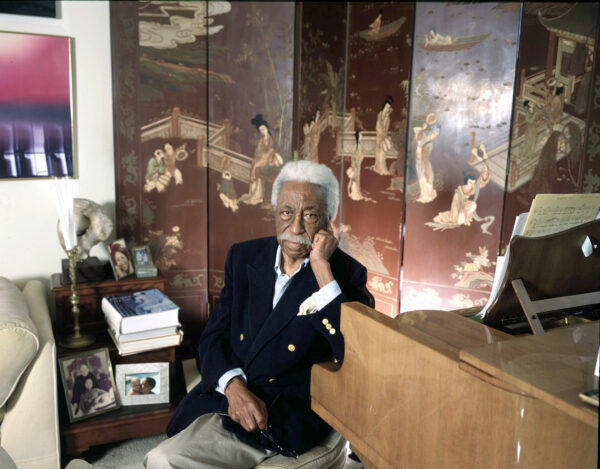One of the world’s most prolific photographers’ collections will now be housed at one of the top historically Black colleges and universities. Almost two decades after his transition, 252 of the artist’s most prized images will now be on display at the institution that gave him his start.

The Gordon Parks Legacy Collection will be housed in Howard University’s Moorland-Spingarn Research Center and available to students and faculty for classwork projects, research assignments, exhibitions and public programs.
Received from the Gordon Parks Foundation as a combination purchase and gift, the acquisition will be celebrated at its annual awards dinner in New York City on May 19.
Having the collection at Howard University is a full-circle moment. Gordon Parks, who died in 2006, started his career in Washington D.C., shooting events on the campus and documenting the lives of its students. Eighty years later, a collection of his work as a documentarian of Black life will live in the archives of the prestigious institution.
Dr. Wayne A.I. Frederick, the president of Howard University, shared his excitement about the collection. “Howard University is proud to be the recipient of such an important collection of work by African American artist and photojournalist Gordon Parks,” said Frederick.
“Mr. Parks was a trailblazer whose documentation of the lived experiences of African Americans, especially during the civil rights period, inspired empathy, encouraged cultural and political criticism, and sparked activism among those who viewed his work,” the president continued.
“Having a collection of his timeless photographs in the Moorland-Spingarn Research Center will allow Howard University faculty, students, and visiting scholars to draw on his work and build upon his legacy of truth-telling and representation through the arts.”
Peter W. Kunhardt Jr., executive director of the Gordon Parks Foundation, said curators from the school and their office painstakingly went through thousands of images that the foundation owns to pull the 252 photographs making up the collection. These pictures were selected based on their educational value and how they will be used for the Howard community.
“Gordon Parks is central to telling the story of African American life, and bringing humanity to that narrative,” Benjamin Talton, director of the Moorland-Spingarn Research Center said.
“Howard University is at the center of the African American experience globally. Obviously, Black life meant something to Gordon Parks,” he continued. “To have a Gordon Parks collection at Howard University is like a foot in a shoe, and I think he’d be pleased.”
Jelani Cobb, newly appointed dean of the Columbia School of Journalism. said, “This is a tremendous opportunity for both Howard University and The Gordon Parks Foundation. Gordon Parks’ work helped define American art in the 20th century and there is no better place poised to help safeguard his legacy than the Mecca of Black education.”
The acquisition is a score for the university, aimed to enhance research on “the African American experience globally.”
Some of Parks’ earliest works are portraits of Black residents of Chicago and Minneapolis in the 1940s, images of Paul Robeson, Frederick Douglass, Sidney Poitier, Duke Ellington, Malcolm X, Stokely Carmichael, Miles Davis Amiri Baraka and Mary Frances Berry. The acquisition includes a 1990’s portrait of Morehouse graduate Spike Lee.
“They are not just photographs, they are studies. Gordon Parks immersed himself in Chicago, in Harlem, in Washington, in Rio de Janeiro,” Talton said. “It is about the art, but it is about Gordon Parks the person. It’s about technique, and light and angles, but also about dropping into the second half of the 20th century.”
Parks lived an extraordinary life, despite never finishing high school and having no formal training in photography.
His life’s work focused on documenting the lives of Black people in America during the Jim Crow South and the booming arts and industrial movements in big cities like Harlem, Chicago and Washington in the early 20th century. He was hired by Life magazine to produce photo essays on race, poverty and the struggle for civil rights.
In one part of his career, he turned his attention to fashion (or fashion turned its attention to him) and shot high-end clothing spreads for magazines like Vogue and Ebony.
He made history as the first Black person to direct a major movie with his 1969 classic “The Learning Tree,” and could be considered the godfather of a particular genre of movie with the debut of his culturally explosive film “Shaft.”
Kunhardt adds, “the arc of this collection is looking at Black pride. It chronicles his career in a way that is accessible to students,” and insists Parks was more than “just a portraitist.”
The director added, “He’s a humanitarian. He was using his camera to show poverty and despair. His pictures could be tough, but they told a story.”
This tremendous acquisition comes weeks after the school named after the renaissance man, Gordon Parks High School, dedicated a tree calling it “The Learning Tree,” after his film in his honor on Monday, May 8.
Actor Kyle Johnson, who starred in the film, attended the ceremony and talked to students about the legendary man that their school bears in name. Parks’ great-niece helped play a role in getting the actor to the school for the special ceremony, ABC 5 reports.
The financial details of the Parks/Howard University acquisition remain undisclosed, but students will return in the fall with access to the extraordinary work.


